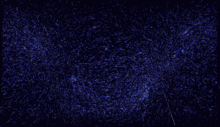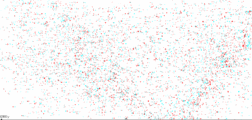Solar apex

The solar apex, or the Apex of the Sun's Way, refers to the direction that the Sun travels with respect to the Local Standard of Rest. This is not to be confused with the Sun's apparent motion through the constellations of the zodiac, which is illusory – this supposed motion is actually caused by the Earth revolving around the Sun. The first person to determine a direction for the solar apex was German-born English astronomer William Herschel in 1783.[1]
The solar apex is in the constellation of Hercules, southwest of the star Vega. There are several coordinates for the solar apex. The visual coordinates (as obtained by visual observation of the apparent motion) is right ascension (RA) 18h 28m 0s and declination (dec) of 30° North (in galactic coordinates: 56.24° longitude, 22.54° latitude). The radioastronomical position is RA 18h 03m 50.2s and dec 30° 00′ 16.8″ (galactic coordinates: 58.87° longitude, 17.72° latitude).
The speed of the Sun towards the solar apex is about 20 km/s.[2] This speed is not to be confused with the orbital speed of the Sun around the Galactic center, which is about 220 km/s and is included in the movement of the Local Standard of Rest. Thus the Sun gains distance towards the apex at about 1/13 its orbital speed. The sun's motion in the Milky Way is not a simple ellipse in the galactic plane; it also shifts ("bobs") up and down with respect to the plane.[3]
The nature and extent of the solar motion was first demonstrated by William Herschel in 1783.
The solar antapex, the direction opposite of the solar apex, is located near the star Zeta Canis Minoris.
Gallery
- Animations of star motions around apex and antapex
-

The movement of stars around the apex (left) and antapex (right) in ± 500 000 years. To view this picture you need 3D glasses (red-green or red-blue).
-

The movement of stars around the apex. To view this picture you need 3D glasses (red-green or red-blue).
-

The movement of stars around the antapex. To view this picture you need 3D glasses (red-green or red-blue).
-

The movement of stars between apex and antapex. To view this picture you need 3D glasses (red-green or red-blue).
References
- ↑ Hoskin, M. (1980), "Herschel's Determination of the Solar Apex", Journal for the History of Astronomy, 11: 153−163, Bibcode:1980JHA....11..153H.
- ↑ See Table 3 on page 13 of Kogut, A.; et al. (1993). "Dipole Anisotropy in the COBE Differential Microwave Radiometers First-Year Sky Maps". Astrophysical Journal. 419: 1. arXiv:astro-ph/9312056
 . Bibcode:1993ApJ...419....1K. doi:10.1086/173453.
. Bibcode:1993ApJ...419....1K. doi:10.1086/173453. - ↑ Priscilla Frisch (2000). "The Galactic Environment of the Sun", American Scientist.